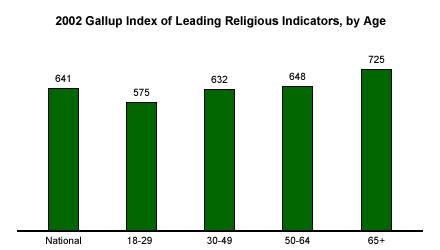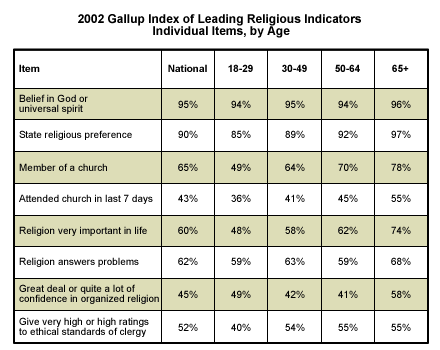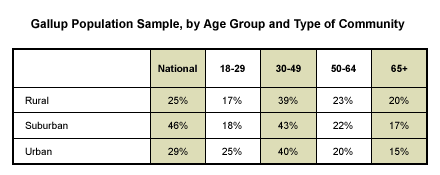The Feb. 11 Gallup Poll Tuesday Briefing article, "Communities of Faith" prompted a comment from Clay Price, research and information manager at Baptist General Convention of Texas, that surely an aging population accounts somewhat for the high level of religiosity in rural America. He made an excellent point -- so we investigated further.
As Gallup has documented over a long period, Americans' likelihood to adopt religious attitudes and behaviors does increase dramatically with age. As George Gallup Jr., wrote in 2002, "As people grow into their middle years, they begin to experience the loss of parents and increasingly face the inevitable changes of life, which may deepen their religious beliefs." Indeed, the 2002 Gallup Index of Leading Religious Indicators* marches steadily upward with age -- from 575 for the youngest group, 18- to 29-year-olds, to 725 among Americans aged 65 and older.

With the exception of ratings for "belief in God or a universal spirit" and the "ethical standards of the clergy," all the other items that make up the Index are rated higher by the oldest Americans than by the overall population. There are several items on which the 65 and older group varies significantly from the national norm:
- Seventy-eight percent of those aged 65 and older are members of a church, compared to 65% of the overall population.
- Fifty-five percent of those in the 65+ group attended church in the last seven days, versus only 43% of the national population.
- Seventy-four percent of older Americans feel that religion is "very important" in their lives, compared to 60% overall.
- Fifty-eight percent of those 65 and older have a "great deal" or "quite a lot" of confidence in organized religion, versus 45% of all Americans.

And as the Feb. 11 article shows, Americans in rural communities (686 Index score) tend to be more religious than those in suburban (633) and urban (613) communities.
A study of the population sample in Gallup's survey** does show that the population residing in rural settings skews slightly older than that in more urban areas -- but not by much. Forty-three percent of rural residents are age 50 or older compared with 39% of suburban residents and 35% of urban residents.

But a closer look at the data reveal that religiosity is higher among rural residents among similar age groups. Specifically, among 18- to 49-year-olds, the Index of Leading Religious Indicators is 589 for urban residents, 601 for suburban residents, and 664 for rural residents. The same pattern exists for Americans aged 50 and older. Urban residents aged 50 and older scored 654 on the 2002 Index, suburban residents in this age group scored 684, and rural residents scored 715.
Bottom Line
While age is clearly related to religiosity in America, age alone cannot account for the higher levels of religiosity evident among Americans living in rural areas. One possible factor in this phenomenon is the idea that in smaller communities, churches are commonly among the only venues for large social gatherings. Churches may also act as the sole providers of counseling, aid to the poor, and social activities (even if those take the form of choir music and Christmas pageants) in rural communities. These activities could certainly lead to an increased prominence of the church in rural areas, especially among young and middle-aged parents who are raising families.
We welcome and appreciate continued questions and comments from readers of the Tuesday Briefing.
*The 2002 Index of Leading Religious Indicators was compiled from surveys of national adults, aged 18 and older, conducted throughout the year.
**Crosstabulation of age by urbanicity from an aggregate of 2002 Gallup Polls
